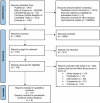Inhalation technique-related errors after education among asthma and COPD patients using different types of inhalers - systematic review and meta-analysis
- PMID: 40102397
- PMCID: PMC11920170
- DOI: 10.1038/s41533-025-00422-0
Inhalation technique-related errors after education among asthma and COPD patients using different types of inhalers - systematic review and meta-analysis
Abstract
In asthma and chronic obstructive pulmonary disease (COPD) incorrect use of inhalers is still common. The aim of the study was to detect whether education improves inhalation skills and whether the type of education influenced the educational effect depending on the device. A systematic review and meta-analysis for errors during inhalation before and after education was performed. The selected data allowed for education assessment of dry powder (DPIs) and pressurised metered dose (pMDI/MDIs) inhalers in a meta-analysis. Education reduced critical errors (risk ratio [RR], 0.28, 95% confidence interval [CI]: 0.17, 0.47, P < 0.00001) and any incorrect use events for DPI (RR = 0.38, 95% CI: 0.21, 0.70, P = 0.002) and pMDI/MDIs, (RR = 0.16, 95% CI: 0.11, 0.23, P < 0.00001). Education improves patient's inhalation skills regardless of the device. The educational effect for pMDI/MDIs depends on the type of educational approach which has not been demonstrated for DPIs.
© 2025. The Author(s).
Conflict of interest statement
Competing interests: The authors declare no competing interests.
Figures





Similar articles
-
Comparison of the effectiveness of inhaler devices in asthma and chronic obstructive airways disease: a systematic review of the literature.Health Technol Assess. 2001;5(26):1-149. doi: 10.3310/hta5260. Health Technol Assess. 2001. PMID: 11701099
-
Maintenance Inhalers for Asthma and COPD in Spain.Respir Care. 2024 Nov 18;69(12):1534-1542. doi: 10.4187/respcare.11643. Respir Care. 2024. PMID: 38906702
-
Device errors in asthma and COPD: systematic literature review and meta-analysis.NPJ Prim Care Respir Med. 2017 Apr 3;27(1):22. doi: 10.1038/s41533-017-0016-z. NPJ Prim Care Respir Med. 2017. PMID: 28373682 Free PMC article.
-
Systematic review and economic analysis of the comparative effectiveness of different inhaled corticosteroids and their usage with long-acting beta2 agonists for the treatment of chronic asthma in adults and children aged 12 years and over.Health Technol Assess. 2008 May;12(19):iii-iv, 1-360. doi: 10.3310/hta12190. Health Technol Assess. 2008. PMID: 18485271
-
Effect of incorrect use of dry powder inhalers on management of patients with asthma and COPD.Respir Med. 2008 Apr;102(4):593-604. doi: 10.1016/j.rmed.2007.11.003. Epub 2007 Dec 20. Respir Med. 2008. PMID: 18083019
Cited by
-
Non-Pharmacological Interventions to Prevent Oropharyngeal Candidiasis in Patients Using Inhaled Corticosteroids: A Narrative Review.Healthcare (Basel). 2025 Jul 17;13(14):1718. doi: 10.3390/healthcare13141718. Healthcare (Basel). 2025. PMID: 40724743 Free PMC article. Review.
References
-
- Yayan, J. & Rasche, K. Asthma and copd: similarities and differences in the pathophysiology, diagnosis and therapy. Adv. Exp. Med. Biol.910, 31–38 (2016). - PubMed
-
- Global Initiative for Chronic Obstructive Lung Disease. Global Strategy for the Diagnosis, Management, and Prevention of Chronic Obstructive Pulmonary Disease (2024 Report). Available from www.goldcopd.org. Accessed July 10, 2024.
-
- Global Initiative for Asthma. Global Strategy for Asthma Management and Prevention, 2024. Updated May 2024. Available from www.ginasthma.org. Accessed July 10, 2024.
-
- Melani, A. S. et al. Inhaler mishandling remains common in real life and is associated with reduced disease control. Respir. Med.105, 930–938 (2011). - PubMed
Publication types
MeSH terms
Grants and funding
LinkOut - more resources
Full Text Sources
Medical

